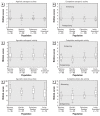Fertility and markers of male reproductive function in Inuit and European populations spanning large contrasts in blood levels of persistent organochlorines
- PMID: 18335090
- PMCID: PMC2265036
- DOI: 10.1289/ehp.10700
Fertility and markers of male reproductive function in Inuit and European populations spanning large contrasts in blood levels of persistent organochlorines
Erratum in
- Environ Health Perspect. 2008 Mar;116(3):276
Abstract
Objective: We synthesized the main findings from an international epidemiologic study on the impact of biopersistent organic pollutants (POPs) on human reproductive function.
Data sources and extraction: We used a database with interview and biological data from 2,269 women and their spouses, and 18 published core papers.
Data synthesis: The study did not provide direct evidence of hormone-like activity of the polychlorinated biphenyl (PCB) congener CB-153 and the main dichlorodiphenyltrichloroethane (DDT) metabolite, 1,1-dichloro-2,2-bis(p-chlorophenyl)ethylene (p,p'-DDE), as serum concentrations of these compounds were not consistently related to either endogenous or exogenous hormone activity in serum. Nevertheless several links bewteen POP exposure and biomarkers of male reproductive function were identified. First, an association between high CB-153 serum levels and low sperm counts was detected within a subgroup of men with short androgen receptor CAG repeat length. Second, a relationship between increased CB-153 serum concentrations and decreased sperm motility was seen in all four studied regions, and indications of reduced neutral alpha-glucosidase activity in seminal plasma point to a post-testicular effect. Third, damage of sperm chromatin integrity was considerably less frequent in Greenlandic Inuits compared with that in European groups, and only in the latter was impairment of sperm chromatin integrity related to POPs. Despite these effects, fertility in terms of time taken to conceive was not related to POPs except in Inuits. A likely explanation of the latter was not identified.
Conclusions: POPs may interfere with male reproductive function without major impact on fertility. The data do not provide direct evidence for endocrine disruption, hence other mechanisms should also be considered.
Keywords: Inuit; polymorphisms; reproductive health; semen quality; sex hormone receptors; time to pregnancy; xenobiotics.
Figures


References
-
- Aitken RJ, Baker MA. Oxidative stress and male reproductive biology. Reprod Fertil Dev. 2004;16:581–588. - PubMed
-
- Anas MK, Guillemette C, Ayotte P, Pereg D, Giguere F, Bailey JL. In utero and lactational exposure to an environmentally relevant organochlorine mixture disrupts reproductive development and function in male rats. Biol Reprod. 2005;73:414–426. - PubMed
-
- Aneck-Hahn NH, Schulenburg GW, Bornman MS, Farias P, de Jager C. Impaired semen quality associated with environmental DDT exposure in young men living in a malaria area in the Limpopo Province, South Africa. J Androl. 2007;28:423–434. - PubMed
-
- Axmon A, Thulstrup AM, Rignell-Hydbom A, Pedersen HS, Zvyezday V, Ludwicki JK, et al. Time to pregnancy as a function of male and female serum concentrations of 2,2′4,4′5,5′-hexachlorobiphenyl (CB-153) and 1,1-dichloro-2,2-bis (p-chlorophenyl)-ethylene (p,p′-DDE) Hum Reprod. 2006;21:657–665. - PubMed
Publication types
MeSH terms
Substances
LinkOut - more resources
Full Text Sources
Miscellaneous

